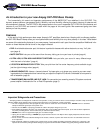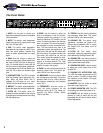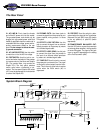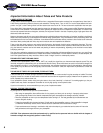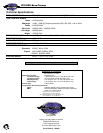
6
SVP-PRO Bass Preamp
Important Information About Tubes and Tube Products
A
BRIEF HISTORY OF THE TUBE:
In 1883, Edison discovered that electrons would flow from a suspended filament when enclosed in an evacuated lamp. Years later, in
1905, Fleming expanded on Edison's discovery and created the "Fleming Valve". Then, in 1907, Dr. Lee de Forest added a third com-
ponent – the grid – to the "Fleming's Valve" and the vacuum tube was a fact of life. The door to electronic amplification was now open.
During World War II, data gleaned from their intensive research on the detectors used in radar systems led Bell Telephone Laboratories
to the invention of the transistor. This reliable little device gained quick support as the new component for amplification. The death of the
vacuum tube seemed imminent as designers, scientists, and engineers reveled in the idea of replacing large, fragile glass tubes with
these small, solid-state devices.
However, there were (and still are) many serious listeners who realized that the sound produced by a "transistor" amplifier is significantly
different from that produced by a tube amplifier with identical design specifications. They considered the sound produced by these new
solid-state devices to be hard, brittle, and lifeless. It was determined that solid-state devices produced a less musical set of harmonics
than tubes. When pushed past their limits, they tend to mute the tone and emphasize the distortion.
Tubes, on the other hand, produce a more musical set of harmonics, the intensity of which can be controlled by the player. This char-
acteristic adds warmth and definition to the sound which has become the hallmark of tube amplifiers. When tubes are driven into clip-
ping, the harmonic overtones can be both sweet and pleasing or intense and penetrating, depending on the musician’s musical taste
and playing technique.
Over the years, application engineers have designed a number of outstanding solid-state amplifiers that sound very, very good. Some
use special circuitry which enables them to simulate the distortion characteristics of a tube amplifier. However, the tube amplifier, still
held in the highest esteem by many musicians, offers a classic "vintage" sound in a contemporary market.
PREAMPLIFIER TUBE TYPES
AND USAGE:
The tubes used in preamplifiers (12AX7, 12AU7, 12AT7, etc.) amplify the signal from your instrument and shape the sound. They are
inherently microphonic (mechanically pick up and transmit external noises). Since these tubes are used in the critical first stages of a
tube preamplifier's circuitry, it is very important to use high-quality, low noise/low microphonic tubes for this application. Although tubes
of this quality may be difficult to find and typically cost more than "off-the-shelf" tubes, the improvement in performance is worth the
investment.
THE NATURE OF TUBES: WHY (AND WHEN) TO REPLACE THEM:
Tubes are made up of a number of fragile mechanical components that are vacuum-sealed in a glass envelope or bubble. The tube's
longevity is based on a number of factors which include how hard and often the equipment is played, vibration from the speakers, road
travel, repeated set up and tear down, etc.
If your preamplifier squeals, makes noise, loses gain, starts to hum, lacks "sensitivity", or feels as if it is working against you, the pre-
amplifier tubes may need to be replaced. Remember to use only high quality, low microphonic tubes.
If you're on the road a lot, we recommend that you carry a set of replacement tubes.
SUR
VIVAL TIPS FOR TUBE PREAMPS:
To prolong tube life, observe these tips and recommendations:
• After using the preamplifier, allow sufficient time for it to properly cool down prior to moving it. A properly cooled pream-
plifier prolongs tube life due to the internal components being less susceptible to the damage caused by vibration.
• Allow the preamplifier to warm up to room temperature before turning it on. The heat generated by the tube elements can
crack a cold glass housing.
• Protect the preamplifier from dust and moisture. If liquid gets into the preamplifier proper, or if the preamplifier is dropped
or otherwise mechanically abused, have it checked out at an authorized service center before using it.
• Proper maintenance and cleaning in combination with routine checkups by your authorized service center will insure the
best performance and longest life from your preamplifier.
CAUTION: Tube replacement should be performed only by qualified service personnel who are familiar with the dangers of
hazardous voltages that are typically present in tube circuitry.





